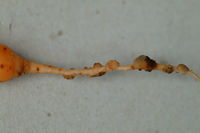Meloidogyne hapla
| Literature database |
|---|
| 299 articles sorted by: |
| • year (descending) |
| • research topics |
| • countries/regions |
| • host plants |
| • list of antagonists |

Author(s): Josef Schlaghecken, DLR-Rheinpfalz
Source: Hortipendium
Meloidogyne hapla Chitwood, 1949 - (northern root knot nematode)
The species is a serious and common root knot nematode of temperate regions, but is also found in tropical and sub-tropical climates. Unlike many other species of Meloidogyne, eggs of M. hapla can survive temperatures below zero. This species has a very large host range and infests crops like potatoes, carrots, tomatoes or lettuce. In infested plants, roots are poorly developed and plants are stunted. For heavy infestations, yield losses of around 50% have been reported, e.g. in alfalfa and clover. Infested carrots or potatoes are usually unmarketable.
Mature females are sessile in the root galls and release eggs into the soil. After completing their development, males leave the roots. After hatching from the eggs, the juveniles can also move over short distances. However, dispersal is mainly through infested plants and soil. Crop rotation with cereals or other non-host crops is recommended for management. Resistant cultivars are also available for some crops. The use of nematicides may not be economical.
| Vernacular names | |
|---|---|
| • Deutsch: | Nördliche Wurzelgallennematode |
| • English: | northern root knot nematode |
| • Español: | nematodo norteno de quiste |
Root galls are about half as large as those of Meloidogyne incognita. The juveniles are around 400 µm long and have a slender stylet with small rounded knobs. For a summary of the biology see the genus Meloidogyne.
- Other images of Meloidogyne hapla (Hortipendium and IPM Images - click to enlarge)

